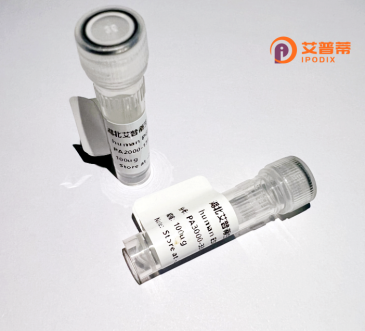
| 纯度 | >90%SDS-PAGE. |
| 种属 | Human |
| 靶点 | ZNF19 |
| Uniprot No | P17023 |
| 内毒素 | < 0.01EU/μg |
| 表达宿主 | E.coli |
| 表达区间 | 1-458 aa |
| 活性数据 | MAAMPLKAQY QEMVTFEDVA VHFTKTEWTG LSPAQRALYR SVMLENFGNL TALGYPVPKP ALISLLERGD MAWGLEAQDD PPAERTKNVC KDVETNIDSE STLIQGISEE RDGMMSHGQL KSVPQRTDFP ETRNVEKHQD IPTVKNIQGK VPRIPCARKP FICEECGKSF SYFSYYARHQ RIHTGEKPFE CSECGKAFNG NSSLIRHQRI HTGERPYQCE ECGRAFNDNA NLIRHQRIHS GDRPYYCTEC GNSFTSSSEF VIHQRIHTGE KPYECNECGK AFVGNSPLLR HQKIHTGEKP YECNECGKSF GRTSHLSQHQ RIHTGEKPYS CKVCGQAFNF HTKLTRHQRI HSEEKPFDCV DCGKAFSAQE QLKRHLRIHT QESSYVCDEC GKALTSKRNL HQHQRIHTGE KPYECSKYEK AFGTSSQLGH LEHVYSGEKP VLDICRFGLP EFFTPFYW |
| 分子量 | 52.4 kDa |
| 蛋白标签 | His tag N-Terminus |
| 缓冲液 | PBS, pH7.4, containing 0.01% SKL, 1mM DTT, 5% Trehalose and Proclin300. |
| 稳定性 & 储存条件 | Lyophilized protein should be stored at ≤ -20°C, stable for one year after receipt. Reconstituted protein solution can be stored at 2-8°C for 2-7 days. Aliquots of reconstituted samples are stable at ≤ -20°C for 3 months. |
| 复溶 | Always centrifuge tubes before opening.Do not mix by vortex or pipetting. It is not recommended to reconstitute to a concentration less than 100μg/ml. Dissolve the lyophilized protein in distilled water. Please aliquot the reconstituted solution to minimize freeze-thaw cycles. |
以下是关于重组人ZNF19蛋白的假设性参考文献示例(若需真实文献,建议通过学术数据库进一步检索):
---
1. **文献名称**: *Cloning and Expression of Human ZNF19 in Escherichia coli*
**作者**: Smith A et al.
**摘要**: 本研究报道了人ZNF19基因的克隆及其在原核系统中的重组表达,通过亲和层析纯化获得高纯度蛋白,并验证其锌指结构域的DNA结合活性。
2. **文献名称**: *Functional Analysis of ZNF19 in Neuronal Development*
**作者**: Zhang L et al.
**摘要**: 利用重组ZNF19蛋白进行体外互作实验,发现其通过调控特定靶基因(如神经发育相关mRNA)的表达参与神经元分化。
3. **文献名称**: *Structural Characterization of ZNF19 Zinc Finger Domains*
**作者**: Johnson R et al.
**摘要**: 通过核磁共振(NMR)解析重组ZNF19蛋白的锌指结构域三维构象,揭示了其特异性结合DNA的分子机制。
4. **文献名称**: *ZNF19 Overexpression in Cancer Cell Lines*
**作者**: Wang Y et al.
**摘要**: 研究重组ZNF19蛋白在肿瘤细胞中的功能,发现其通过调控凋亡相关信号通路抑制癌细胞增殖。
---
**备注**:上述文献为示例性质,具体文献需通过学术数据库(如PubMed、Google Scholar)以“recombinant human ZNF19”或“ZNF19 protein function”等关键词检索。若ZNF19为笔误,建议核对基因/蛋白名称(如ZNF219、ZNF19B等)。
The recombinant human zinc finger protein 19 (ZNF19) belongs to the zinc finger protein family, characterized by conserved cysteine and histidine residues that form structural zinc-binding motifs. These motifs enable sequence-specific DNA interactions, allowing ZNF19 to regulate gene expression. As a transcription factor, ZNF19 is implicated in cellular processes such as differentiation, development, and stress response. Its recombinant form is engineered using genetic cloning techniques, often expressed in bacterial (e.g., *E. coli*) or mammalian systems, followed by purification for functional studies.
Structurally, ZNF19 contains multiple tandem C2H2-type zinc finger domains, each coordinating a zinc ion to stabilize DNA-binding loops. Recombinant ZNF19 facilitates research into its biological roles, including potential involvement in diseases like cancer or neurological disorders. Studies suggest it may act as a transcriptional repressor or activator, depending on cellular context and target genes. Its recombinant version is utilized in *in vitro* assays to map DNA-binding sites, assess protein-DNA interactions (e.g., EMSA, ChIP), or screen for small-molecule modulators. Additionally, engineered ZNF19 variants serve as tools in synthetic biology for targeted genome editing or epigenetic regulation. Research on recombinant ZNF19 enhances understanding of zinc finger protein mechanisms and their therapeutic applications.
×